 Phil Howell
Editor-in-Chief
Photographers:
Tom Wood
Phil Howell
Editor-in-Chief
Photographers:
Tom Wood
Most of us are familiar with the function of the driveshaft. It transmits torque from the transfer case to the differential through varying angles and lengths of tube. Although many of us have had a driveshaft failure, few of us have a real understanding of exactly what's causing our driveshafts to vibrate, shudder, or break. We talked with Tom Wood, builder of driveshafts at Six States Distributing, and he filled us in on the basics.
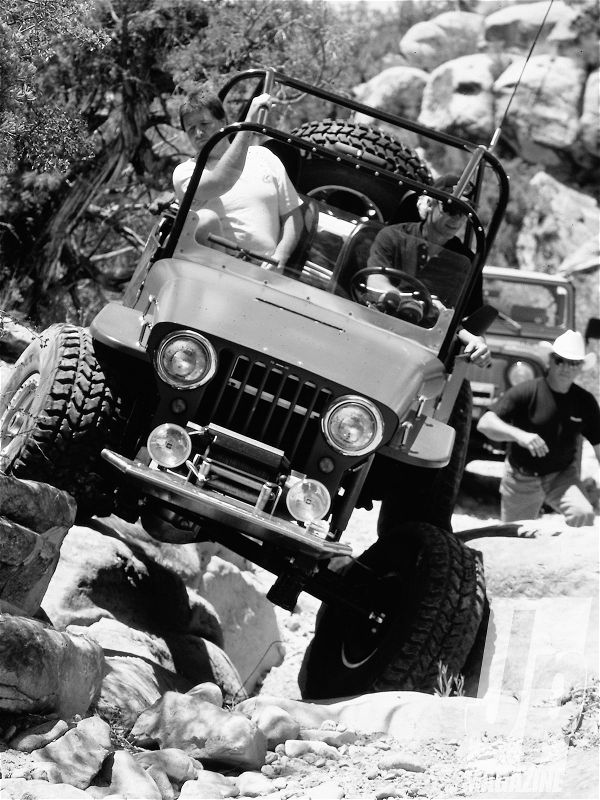
First, make sure that the driveshaft in your Jeep is in sound working order. This is for your own safety and comfort, as well as for the safety of the guy behind you on the freeway going 70 mph. It certainly is no fun having your weekend outing or the trip to the corner market interrupted by a driveshaft failure, which can be an inconvenience at best and deadly at worst.
Driveshaft and U-joint failures can be attributed to one or a combination of factors. These factors are maintenance, driver abuse, external damage, improper installation, poor driveline geometry, or the quality and strength of the components.
On stock applications, poor maintenance is the number one killer of driveshafts. Unfortunately for the consumer, most domestic stock driveshaft components have little or no provision for lubrication. The vehicle manufacturers are saving a couple of bucks per vehicle by not putting grease fittings on the wearing components. Because of this, there isn't much that can be done to prevent a stock driveshaft from wearing out. We can give the driveshaft a quick visual checkup to ensure our safety, though. It doesn't take much time and will never hurt to check things out any time you're under the vehicle.
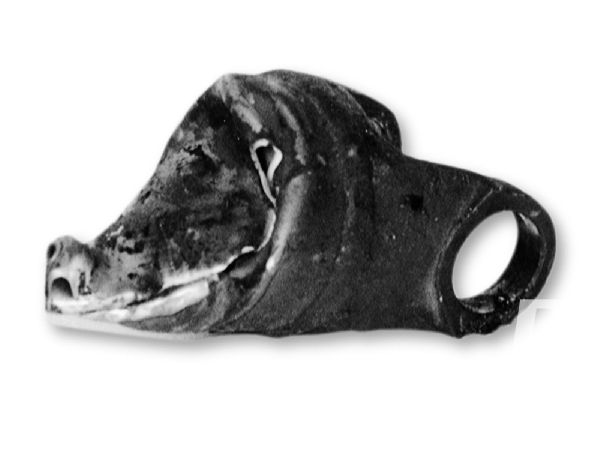 This twisted, broken tube shows what happens when excessive load is applied to an undersized driveshaft. Horsepower or stress from the trail could be the culprit here. Regardless of whatever caused the break, stock tubes are usually quite weak.
This twisted, broken tube shows what happens when excessive load is applied to an undersized driveshaft. Horsepower or stress from the trail could be the culprit here. Regardless of whatever caused the break, stock tubes are usually quite weak.
Inspection of the driveshaft requires that the vehicle's transmission or transfer case be put in neutral. Be sure to set the parking brake. This is important because if there's any pressure on the driveshaft, you can't detect the minimal clearances that will be the first indicators of an impending problem.
Try twisting in opposite directions each of the yokes that attach to the U-joint and try to move them side to side, checking for movement independent of the U-joints. If you have any detectable play in any direction, you have too much. Many times you can have a U-joint that's beginning to seize up, and you won't be able to observe any play in the joint. When that happens, you may see a rusty oxidization on the U-joint around the bearing cap seals. While driving the vehicle, you might also hear a squeaking noise that will start out slow and cycle faster as the vehicle moves faster. The squeaking may disappear at high speeds.
Check to make sure the U-bolts or strap and bolts are tight. Also look to see that the bearing caps have retained a tight fit in their respective yokes on the driveshaft. A cap that has lost its press fit will typically have a clean, polished area on the end from spinning in the bore of the yoke. This is also a good time to look for things like a dented or twisted tube, missing balance weights, crud on the driveshaft, and anything else that could cause a vibration problem.
You'll want to check the attaching yokes. Are they securely attached to the transfer case or differential? Often, the nut on either of these yokes will begin to back off. If that's the case, you'll be able to see the yoke move independently of the output shaft or the pinion shaft. Be careful in your diagnosis here, since the symptoms may be a result of bearing wear. To arbitrarily tighten the nut will usually accelerate the failure of a worn bearing. If you discover the yoke is loose, it may be a good time to drain the gearbox to thoroughly inspect the oil for excessive metal contamination. In the event of a bearing failure, the oil will typically have a glittery appearance.
PhotosView SlideshowIf you are lucky enough to have grease fittings in your U-joints, use them. You should always grease until you see clean grease coming out of all four of the seals on the universal joint. It's a myth that this purging will damage the seal. They're designed to purge. We recommend that you do this every time you change your oil and when you get back from that wet, muddy four-wheeling adventure. You'll be flushing the water and grit out of the bearings, for longer U-joint life
There also may be a grease fitting on the slip yoke (the female sliding component) of the driveshaft. The slip yoke and spline stub are a couple of the more expensive components in a driveshaft. I don't believe that you can ever grease it too much (the EPA may disagree), and grease is a lot cheaper than finish-machined steel parts.
Proper greasing of the slip yoke will depend on the location of the grease fitting. On most older applications, the grease fitting is in the body of the slip yoke near the area that accepts the U-joint. On many newer applications or reworked driveshafts, the grease fitting is in the dust cap at the end opposite the U-joint (on either type of slip yoke, you'll find a relief hole in a plug that's in the end of the yoke under the U-joint). With the first type, you need to put your finger over this hole and pump grease until you see clean grease coming out past the dust cap on the opposite end. Unless you do this, grease will simply fill the cavity in the slip yoke that's not filled with the spline stub, and any excess will come out of the relief hole. With the second type, pump grease until you see clean grease coming out this relief hole. The object is to make sure that clean grease will completely coat the wearing areas of the slip yoke and spline stub.
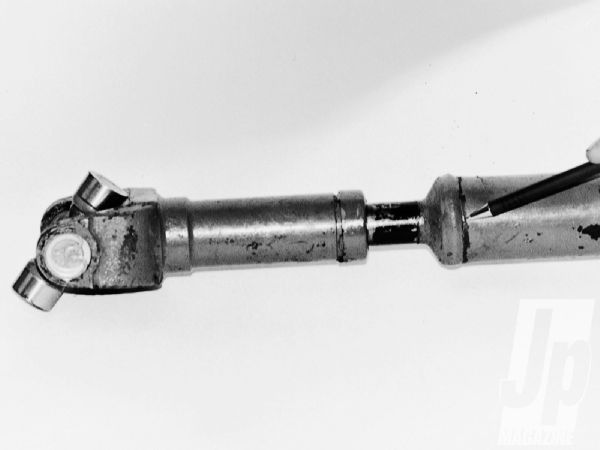 To find twisted tubes like this, look for cracks in the paint or scaling of the surface oxide next to the weld. A good time to do this is during your biannual driveshaft inspection.
To find twisted tubes like this, look for cracks in the paint or scaling of the surface oxide next to the weld. A good time to do this is during your biannual driveshaft inspection.
Performing this procedure regularly is especially important on the front driveshaft. That's because every time you hit a bump in the road, your driveshaft will compress and extend. This is a lot like a sawing motion. On your rear shaft, the driveshaft is always turning and circulating the grease around. But on the front shaft, because it's seldom used at high speeds, this sawing motion will wipe out the grease film, allowing for metal to metal contact and will accelerate wear, as compared to the rear shaft. Many people complain to driveline shops of the short life of their front driveshaft even though they "hardly ever use four-wheel drive."
Hardly ever using four-wheel drive is, in fact, a big part of the problem. We suggest that you periodically engage the front hubs or put the transfer case into four-wheel drive mode without the hubs engaged and drive for about 30 minutes at a relatively high speed. By doing this on a regular basis, you should also be able to notice any problems in their infancy on the front shaft.
If you have a double cardan or constant velocity (CV) type of driveshaft, grease fittings are usually present, although short of removing the driveshaft, they may be difficult to see and impossible to get to. On a Spicer type of CV driveshaft, there will usually be a flush-type grease fitting for lubrication of the center pivot point. The problem is when the CV is opened where it would be accessible, the fitting is at the top of the shaft, where you can't see it. If you turn the shaft until the fitting is at the bottom, the knuckle closes up and you can't get to it. The only viable solution is to disconnect the driveshaft at the transfer case end, drop it down, and then grease it. This should be done at least twice a year.
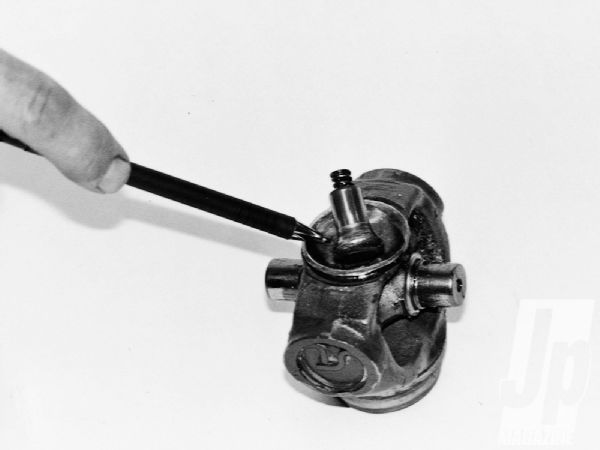 Excessive driveline angles caused this CV pin yoke to fail. Remember that 15 degrees is the maximum. Even at 15 degrees, you may have to relief-grind the CV to allow for enough movement.
Excessive driveline angles caused this CV pin yoke to fail. Remember that 15 degrees is the maximum. Even at 15 degrees, you may have to relief-grind the CV to allow for enough movement.
Of course, most of us use our Jeeps for much more than the occasional trip to the ski lodge. We continually build problems into our vehicle while trying to improve its performance in other areas. Taller tires, differential changes, higher-horsepower engines, suspension lifts, and transmission swaps will all affect the life of the U-joints and driveshaft. With many of these modifications, there's no factory-approved solution
Suspension lifts are the single biggest factor in unacceptable driveshaft and U-joint life or performance. Most lift kits only address the issue of elevation. The truth is most suspension lifts adversely affect proper driveline geometry-especially on short-wheelbase vehicles. We need that lift, though, to upgrade our suspension and to get the clearance required to accommodate taller tires.
With conventional two-joint driveshafts, it's very important to keep the output of the transfer case and the pinion parallel within one degree and in relationship to either of these two shafts. The driveshaft itself should be running at an angle no greater than 15 degrees. This 15-degree limit is a pushed limit, well beyond what most factory engineers would allow. Don't think, "Hmm, if they say15, I can go to 20. If you can't fall within this parameter or are close and want to optimize the life and smoothness of the driveshaft, you'll want to pitch up the differential so that the pinion points directly at the output of the transfer case and use a double cardan (CV) type of driveshaft. The net effect of this will be minimal joint angles at the differential end (ideally less than 3 degrees). This will also lower the joint angle at the transfer case end of the driveshaft.
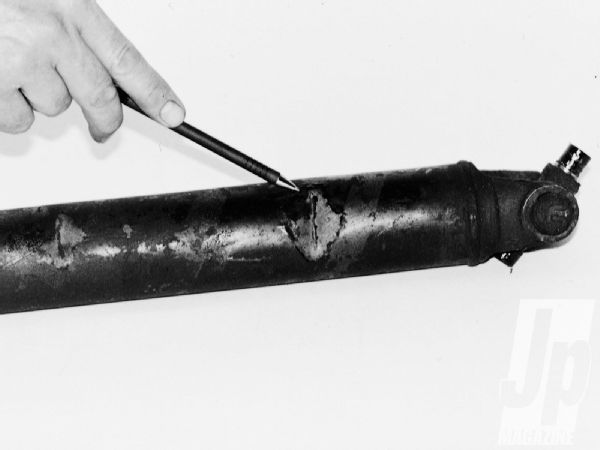 An excessive load or excessive angle caused this broken bearing bore on a yoke. Unfortunately, our Jeeps usually have driveshafts that are fairly short and are on steep angles because of our suspensions. Try to use a CV driveshaft and rotate the pinion up until it points at the transfer case output. This will relieve the stress on the yoke.
An excessive load or excessive angle caused this broken bearing bore on a yoke. Unfortunately, our Jeeps usually have driveshafts that are fairly short and are on steep angles because of our suspensions. Try to use a CV driveshaft and rotate the pinion up until it points at the transfer case output. This will relieve the stress on the yoke.
Unless you do one or the other of those two things, you'll have torsional vibration. This torsional vibration is a result of the nonuniform rates of acceleration and deceleration through the elliptical path of the universal joint (that's easy for us to say). In some cases, you may not be able to feel it, but we can assure you, it's there. You just can't argue with physics. You might think that this vibration is something you can live with, but you are building and releasing torque two times per revolution on the driveshaft and other powertrain components. This pressure has to go somewhere, so it causes the drivetrain components to flex and distort two times per revolution. Eventually, that will cause fatigue failure.
Many times people will install very beefy driveshafts and do the most extreme trails with no problems. Then, while pulling out of their local supermarket, they'll suffer a broken driveshaft that's only under a modest load at the time. That's a classic example of fatigue failure.
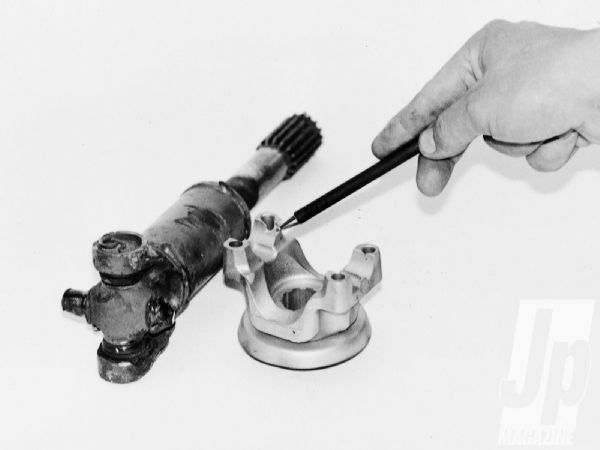 Here's a damaged end yoke and a burned U-joint. This type of joint failure is common when you have a damaged or twisted attaching yoke. Always replace damaged parts, even if they're still working OK. It's always cheaper in the long run.
Here's a damaged end yoke and a burned U-joint. This type of joint failure is common when you have a damaged or twisted attaching yoke. Always replace damaged parts, even if they're still working OK. It's always cheaper in the long run.
Excessive angles are also a big problem. Often it's necessary to relief-grind portions of the driveshaft or the attaching yokes to allow for extra momentary articulation through the driveshaft. This should only be done to allow for things like axle droop, spring wrap, and frame flexing and not as a cure-all. As the U-joints operate at greater angles, they'll create increasing axial loads on the retaining yokes of the driven shaft. This will cause the joint to rip out the end of the driven shaft. This is a result of the tendency of the U-joint to transmit torque in a plane that's perpendicular to the driving shaft. At the transfer case end, the driveshaft is the driven shaft. At the differential end, the driveshaft is the driving shaft. We often equate this to using a flex socket at the end of an extension. In a straight line it will work well, but at an extreme angle it will be difficult to keep the socket on the nut or bolt. The most common failures are the U-joint pulling out of the driveshaft itself at the transfer case end and breaking the retaining strap and bolts on the differential pinion yoke. This type of failure is especially common in lifted, short-wheelbase Jeeps such as the Wrangler and CJ.
Make sure that you have no binding interferences in the driveshaft at all extremes of shaft operation. It can be difficult to simulate the extent of suspension travel and frame-flexing in your garage or driveway or even on a ramp. Allow a little extra margin for things that you can't simulate. For example, you're driving down the highway and your rearend goes airborne because of the stored energy from compressed springs and their recoil effect. Your differential may fall well below what it would if allowed to hang freely from the vehicle.
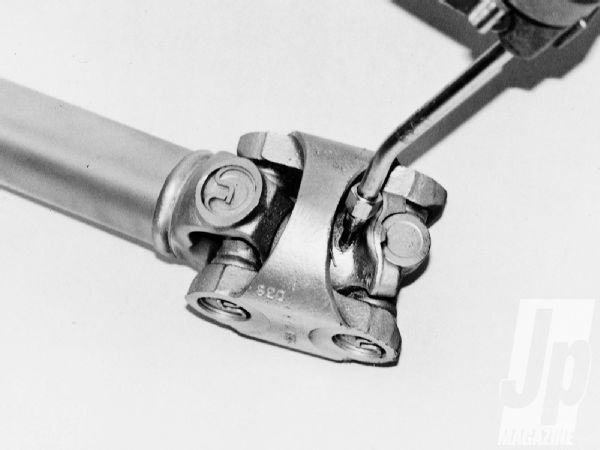 Greasing the CV in its center pivot point may require removal of the driveshaft. This takes a little longer to do, but is much cheaper in the long run.
Greasing the CV in its center pivot point may require removal of the driveshaft. This takes a little longer to do, but is much cheaper in the long run.
Driveshaft travel, from full spring compression to full spring extension, is also an issue that will need to be addressed. On a front axle with shackles in the front and arched springs, as the springs compress, if nothing else happened, the driveshaft would have to get shorter. But, as the springs compress, shackles will swing away from the differential. Again, if nothing else happened, the driveshaft would lengthen. As it is, the two things work in opposition to each other, and the driveshaft will have a relatively stable length. The extent of travel on an existing application can usually be determined by looking at the wear pattern on the spline stub from the dust cap on the slip yoke.
There are many configurations to which the above principle does not apply. Most notably, a front shaft with a shackle reversal. In that situation, the two normally compressive and extending actions are now working in tandem. This will cause the driveshaft to compress and extend substantially more than it would otherwise. Additionally if you have flat springs, the driveshaft will tend to compress only minimally but extend substantially. A special note to you YJ owners with a shackle reversal: Make sure you have enough room for the driveshaft to compress (shorten). Salvage yards are doing a great business in NP231 transfer cases, replacing those that have broken because the front driveshaft was driven into the case on the road or trail. It's prudent to at least try to simulate the full range of movement for the driveshaft through the extent of suspension travel to make sure your driveshaft meets your needs.
Breaking the driveshaft or U-joints can be the result of a number of different causes. Assuming that you're not having one of the problems outlined above, the first thing you may want to look at is the quality/strength of the components themselves. Original equipment driveshafts are not built for ultimate strength. Typically, the tube will be the weak point on a factory shaft. When you're having a new driveshaft built or an old shaft reworked, increase the tube diameter, wall thickness, and grade of tube used. The cost differential will be minimal in the short run, and the potential savings for the long haul will be substantial.
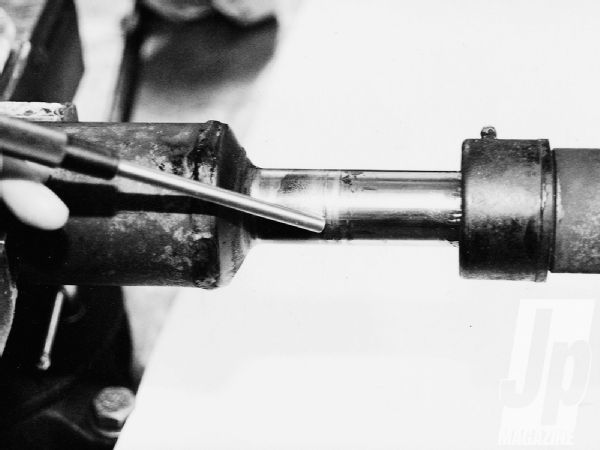 The wear pattern left by the dust cap of the slip yoke on the spline stub will usually be a good indicator of whether the shaft is running in the proper position and the extent of travel from compression to extension.
The wear pattern left by the dust cap of the slip yoke on the spline stub will usually be a good indicator of whether the shaft is running in the proper position and the extent of travel from compression to extension.
There's a lot of talk about increasing joint sizes to accommodate high-horsepower engines. Due to limited parts availability, there will be upper limits to how large a U-joint you can install against any particular transfer case or differential. Additionally, a larger U-joint will usually incur a binding interference at a lower degree of articulation than a smaller U-joint.
Beyond increasing their size, the quality of your components is more likely the most significant improvement that can be made for increasing the strength of your powertrain.



Experience has shown that Spicer components are worth hunting and asking for. The tube should be drawn over a mandrel (factory tube is cold-rolled electric-welded). This will nearly double the yield and tensile strength of a comparable size of tube. The best weld will be done with the MIG process. Additional strength will be the result of the uniform consistency of the MIG weld having a lower potential for stress risers.
Also consider that if you intend to use all that 500 hp available in your Jeep, while in low range and First gear, it would be impossible to assure that you won't break something. If horsepower is constant (which it would be at a given rpm of the engine) and you halve the speed on the output shaft of the transfer case (low range) you will double the torque on the driveshaft. Compound-low gearsets in many of today's transfer cases make things even worse.
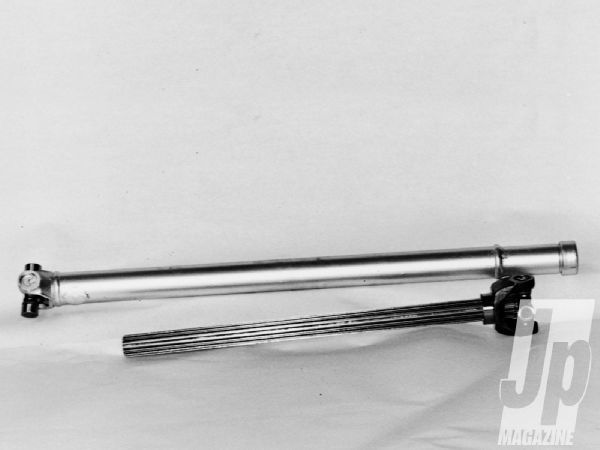 Some applications, such as Jeeps with shackle reversals or super-travel suspensions, may demand extreme travel in the slip yoke. This shaft has nearly 2 feet of splines.
Some applications, such as Jeeps with shackle reversals or super-travel suspensions, may demand extreme travel in the slip yoke. This shaft has nearly 2 feet of splines.
One hundred hp at 3,000 RPM equals 175 lb-ft of torque. One hundred hp at 300 rpm equals 1,750 lb-ft of torque. You'll find that if you brace your vehicles against an immovable object or place the wheels into a deep hole, the engine can develop enough torque to break anything we could conceivably build and install.
Bearing that in mind, what do we do? Drive sensibly and take it easy. When you're out climbing that rocky hill and your wheels start to bounce, do you give it gas? Most broken driveshafts, U-joints, axles, transmission, or transfer cases are the result of high-stress-impact loads. Easy, elegant four-wheeling will save your driveshaft and other equipment every time. We do realize there are those situations where pedal-to-the-metal is the only way to go and, well, we take our chances then.
Proper driveshaft setup and maintenance serves four-wheelers well. If you have questions that haven't been addressed in this feature, give Tom Wood at Six States a call. Doing it right the first time ensures that a pesky broken driveshaft won't ruin that trail ride you've looked forward to for a year. Remember, getting it right guarantees against your getting the shaft.


